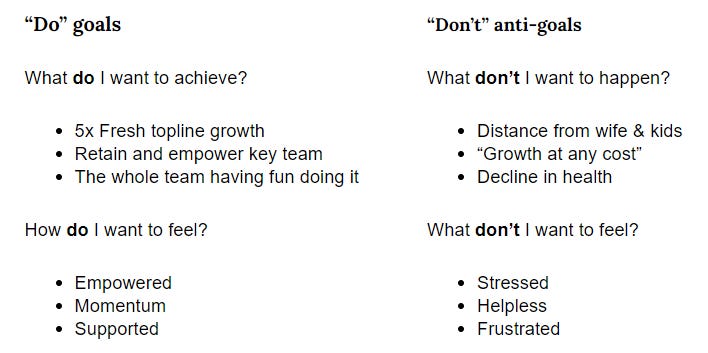Anti-goals: The cheat code to better strategy.
Goals are great, but they are like looking at revenue without considering expenses, or having a big night out and not worrying about the following day. You're looking at the benefit whilst ignoring the cost.
Anti-goals are the underutilised framework that resolves this issue. They ensure that you're winning the battles and the war, that you don't have pyrrhic victories, or that long-term consequences don't mar your short-term success.
Before I knew they were called "anti-goals", I used to refer to them as "shit I don't want to happen". You're welcome to use the same phrase as a substitute, but the important thing is that you know how to set them. Here are two ways that I do them:
The "Without" Method
The first way is the "without" method, which helps ensure the consideration of the direct cost of achieving a goal. It works by adding a new part to an existing goal that explains the cost that you wish to avoid.
For example, Napoleon's goal might have been, "I want to capture Vienna by October without losing more than 10% of my troops."
Using the "without" method inherently makes a goal more sustainable in the long term. To continue the example, Napoleon could have captured Vienna and lost 25% of his troops, but that would've set him up for long-term failure.
A more personal one - this one is real - is, "I want to 5x the company's revenue without causing stress to my wife."
I do not doubt that I can hit this leading goal of 5x'ing InvestorHub next year, but there are many ways I could do it that would inflict stress on Kate (my wife). Not being home, working weekends, spending less time with our kids, or financial stress - if these occur, the cost of achieving my goal may not be worth it.
A listed CEO's goal and anti-goal might be, "I want to slow growth to manage financials without the share price dropping."
In this way, the goal and anti-goal become one: she cannot achieve the goal unless she also achieves the anti-goal.
Achieving goals are hard enough, and the "without" method makes this even harder. But as I said at the start: there is no small-boy stuff here!
The "Do, Don't" Method
Sometimes your goals and anti-goals cannot be explicitly linked, which limits the efficacy of the "without" method. In this instance, you need to trade the clarity of the "without" method for the more versatile "do, don't" framework.
The "do, don't" framework is just two lists, a to-do list and a to-don't list, that you write into two columns. The goals and anti-goals are typically listed as a series of outcomes. They can range from business outcomes to more personal ones.

The "do, don't" method helps keep things in perspective with each other, no matter how unrelated they may seem. This is important to me because even though the "without" method is a much more concrete framework, it can lead to unintended consequences.
Either Or, Just Choosing One Is An Advantage!
Whether you choose the "without" or the "do's, don'ts" method, just choosing to include anti-goals in your annual strategy will put you ahead of the pack - as 88% of people don’t set any goals.
If you're someone who already has them, then please let me know, as I'd be curious to see them. If you're interested in learning more about mine, then get in touch, and I can jam on them with you.
